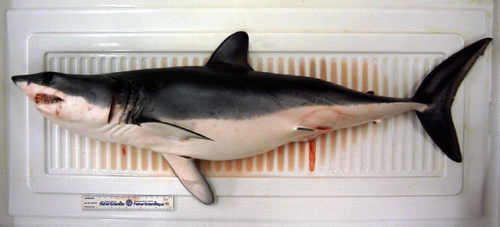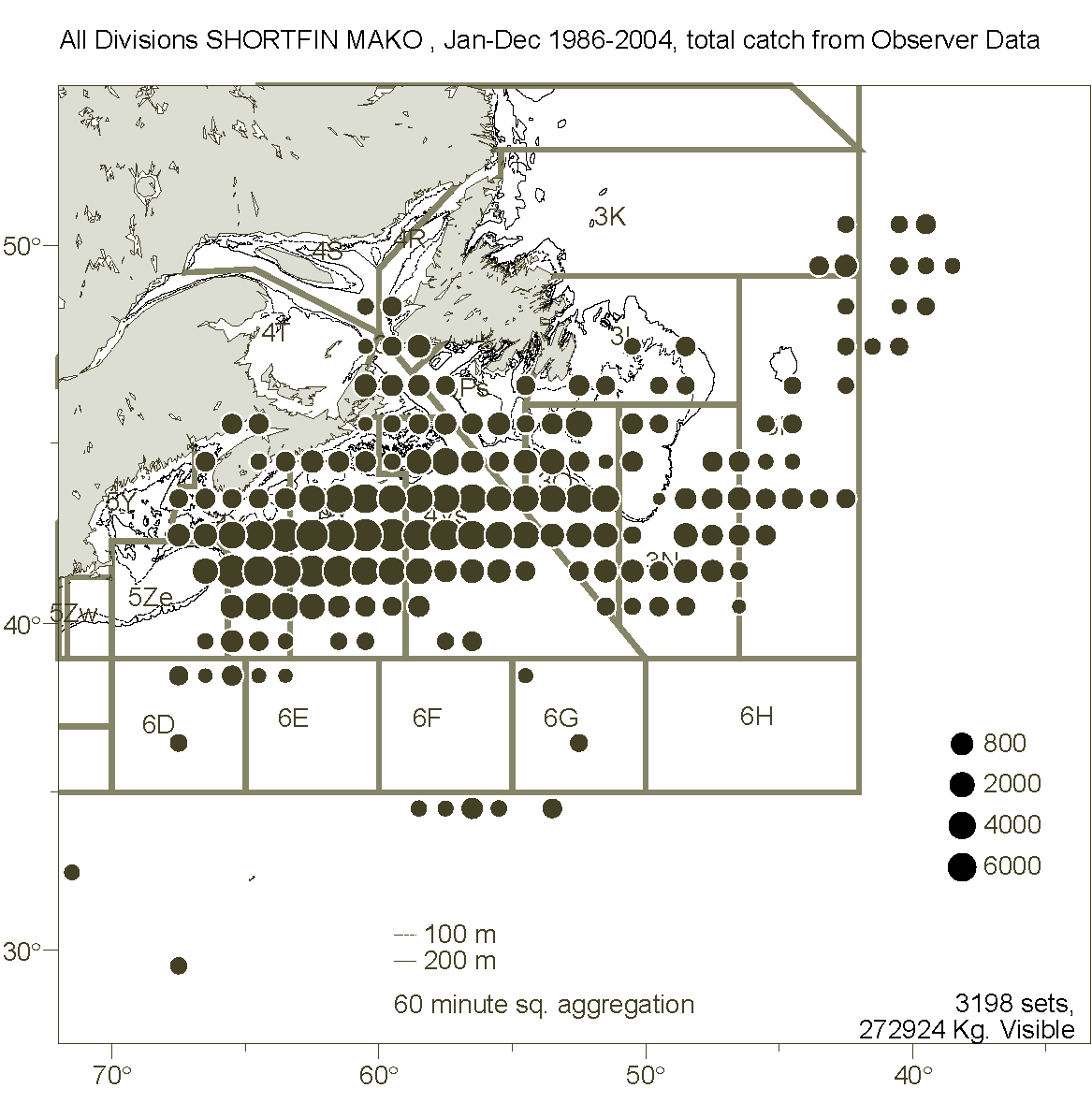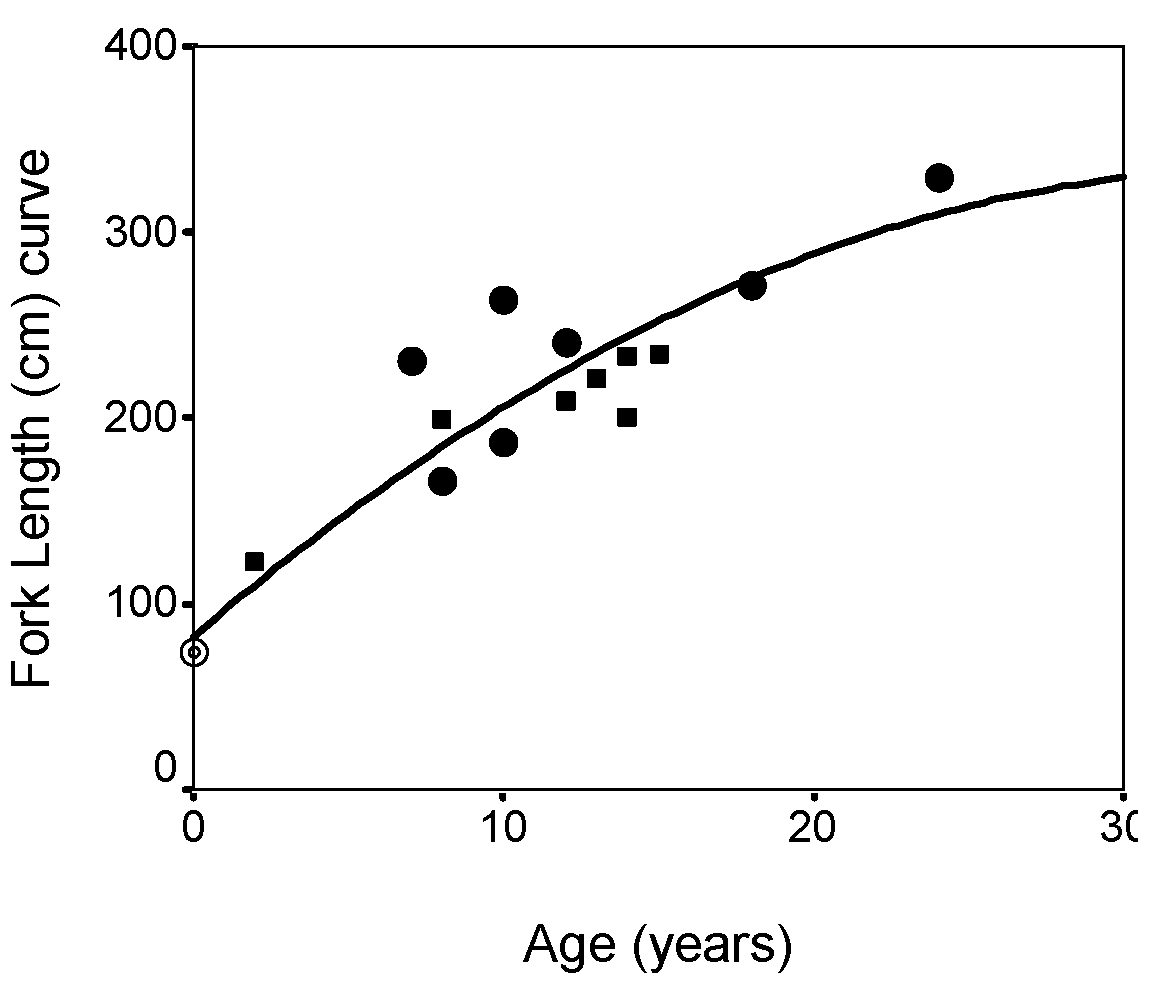Shortfin mako shark research
Isurus oxyrinchus
Species profile
For more information on shortfin mako sharks, please visit the shortfin mako shark page.

Figure 1 : Shortfin Mako shark

Figure 2 : Chart showing shortfin mako catches.

Figure 3 : Growth of makos in Canadian waters. Closed circles show females, while the closed squares show males. From Campana et al. (2004) (CSAS resdocs - 2004/094)
Distribution in Canadian waters
Mako sharks are reasonably common in offshore Canadian waters in the summer and fall months. In the map below (adapted from Campana et al. 2004), the distribution of some of the makos caught by commercial fishermen is shown. Note that each symbol corresponds to many sharks, with the size of the symbol proportional to the total weight of the sharks as shown in the legend.
Determination of age and growth rate
A few dozen mako shark vertebrae have been sectioned in the past two years, revealing growth bands which are known to form yearly. Although the number of makos that has been aged is small, they were enough to produce a preliminary growth curve, as shown below.
Population dynamics
Shortfin makos are a seasonally-resident large shark species in Atlantic Canada. Although avidly sought by recreational fishers, they are caught most often by commercial fishers directing for swordfish or tuna, who consider them to be a high-value bycatch. Tagging studies indicate that they are highly migratory, seasonal residents of Canadian waters, representing the northern extension of a North Atlantic-wide population centred at more southerly latitudes.
Until now, nothing was known of the population health of makos in either Canadian or North Atlantic waters. By integrating our research results on commercial catch rates, shark derbies, and age determinations, we prepared a first analysis of shortfin mako shark status in Canada (Campana et al. 2004). Annual catches in Canadian waters average 60-80 mt per year, which represents but a small part of that estimated for the North Atlantic population as a whole. Our new ageing results indicate that the species grows more slowly than was reported previously, thus making the population less productive and more susceptible to overexploitation than has been reported. Although a catch rate index did not show any evidence of a decline in abundance, the average size of mako sharks in the commercial catch has declined since 1998, suggesting a loss of larger sharks. These results are broadly consistent with a published report of population decline, although it appears unlikely that current fishing rates in Canada are having an appreciable impact on the population. Since mako sharks are highly migratory, and since it appears that there is a single population in the North Atlantic that is shared by multiple countries, international action will be required to reduce mako shark population mortality.
DFO carried out a Recovery Potential Assessment on makos in 2006. Further detail on this assessment is provided in Campana et al. (2006).
Satellite tagging to determine movements and post-release mortality
Shortfin makos are most commonly caught by commercial longliners directing for swordfish or tuna, who consider them to be a high-value bycatch. Conventional tagging studies suggest that makos are highly migratory, and are only seasonal residents of Canadian waters. To better understand mako movements into and out of Canadian waters, 20 satellite tags were attached to makos in 2011 and another 20 in 2013. The results of the study will soon be analysed and should greatly improve our understanding of mako movements and biology, and will improve international efforts to determine sustainable catch levels.
Publications
- Proceedings of the Maritime Provinces Recovery Potential Assessment of Atlantic Shortfin Mako, White Shark, and Loggerhead Turtle; 28-30 November 2006
- Proceedings of the Zonal Peer Review Pre-COSEWIC Assessment for Shortfin Mako (Isurus oxyrinchus) in Atlantic Canada; Semptember 16, 2015 (CSAS Pro - 2015/062)
- Observations on shortfin mako shark (Isurus oxyrinchus) in the North Atlantic (p.17) (CSAS resdocs - 1996/026)
- Biology, Fishery and Stock Status of Shortfin Mako Sharks (Isurus oxyrinchus) in Atlantic Canadian Waters. (CSAS resdocs - 2004/094)
- Assessment of the Recovery Potential of Shortfin Mako Sharks in Atlantic Canada (CSAS resdocs - 2006/091)
- Recovery Potential Assessment Report of Shortfin Mako Sharks in Atlantic Canada
- Shortfin Mako Shark
- Date modified: